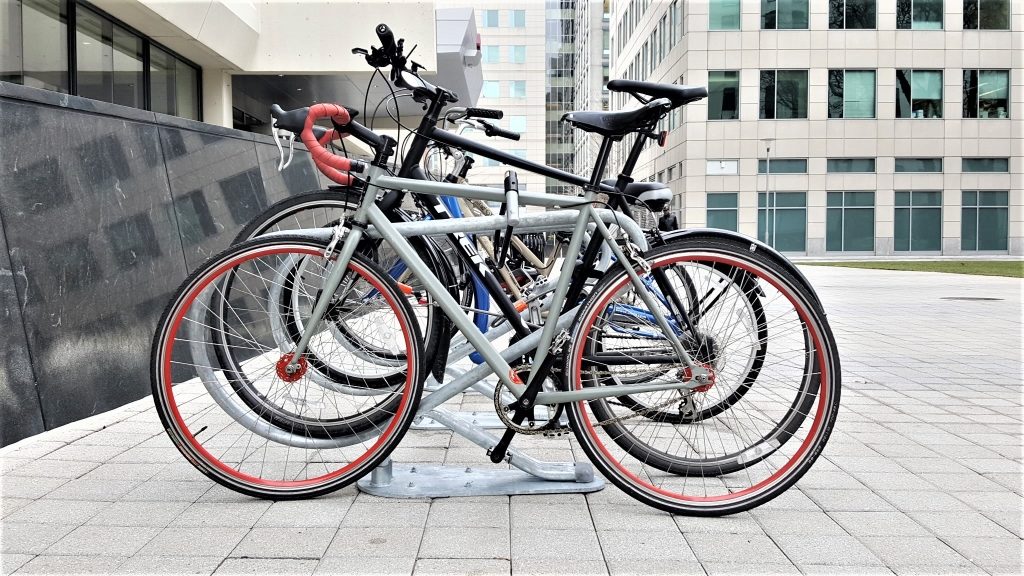Originally published at: Find out how Flycycle is revolutionizing urban biking with IoT-connected bike racks – Particle Blog
Alternative forms of transport like dockless electric scooters and bikes are soaring in popularity, but parking them is becoming a huge problem. Flycycle co-founders Julia Hansen and Jeffrey Olinger set out to solve the parking problem for local Boston cyclists with a specialized connected bike rack. The team designed a rack that offers easier locking for cyclists, takes up less space in already crowded urban sidewalks, and is now connected to the cloud using Particle cellular IoT and mesh solutions.
Bike parking for dense urban environments
 Flycycle installation at Galaxy Park
Flycycle installation at Galaxy Park
A Flycycle bike rack requires only 30” of space between racks, whereas a typical rack need about 36”. Three years ago, Flycycle began dreaming up a more space efficient bike rack when the team entered their design in the MIT Climate CoLab’s competition for high-density urban bike parking. Their prototype won first place and following the victory, city officials from Cambridge, MA encouraged the team to apply for a grant which would give them the funds to expand their fleet of racks.
From prototype to pavement: the Lightning Bug rack
 The Flycycle bike rack in action in the greater Boston area.
The Flycycle bike rack in action in the greater Boston area.
While researching how to further enhance the utility and desirability of bikes racks, the Flycycle team connected with Bob Vinci, an engineer and data expert. Vinci loved the Flycycle rack design and knew he wanted to help improve local bike parking.
Vinci recommended that the team try out Particle to enhance the bike racks. Through their collaboration, Vinci helped the team build Lightning Bug rack, a Particle-connected set of bike racks capable of locking twelve bikes all the while entertaining passersby with an LED performance. Not to mention keeping bikes safe and secure.
“There is so much infrastructure that Particle provides, from the web IDE to all the cloud services… It really gives a lot of power to a small engineering group or even a single practitioner, which is where I was coming from, to do a lot very quickly.”
Bob Vinci
Connecting a community with bike racks, IoT, and data
 Flycycle’s Lightning Bug rack in Technology Square, Cambridge, MA
Flycycle’s Lightning Bug rack in Technology Square, Cambridge, MA
The Lightning Bug rack uses Particle Xenons and a single Boron that acts as a gateway between the mesh network and the cloud. Alongside the Particle hardware are PIR sensors that detect when pedestrians and cyclists approaches the Lightning Bug rack. When someone is nearby, the racks illuminate in colorful patterns created from built-in NeoPixel LEDs.
Currently, twelve Lightning Bug racks are deployed outside Aeronaut, a popular brewery and beer hall in Somernova, Somerville’s Innovation Hub. It’s been a hit with both bikers and those in line for a beer, but the team isn’t done yet. Julia hopes to expand the capabilities of the light show further, including allowing passersby to control the lights themselves through text or an app.
The road ahead for Flycycle
 The road ahead for Flycyle is full of innovation and new features
The road ahead for Flycyle is full of innovation and new features
The innovation doesn’t stop here, though. The Lightning Bug racks also include an accelerometer that the team hopes to eventually use to determine whether a bike is attached to the rack by detecting movement on the rack. This data can be used to better map and study where cyclists actually ride and park, helping city planners and property managers better utilize the limited sidewalk space of urban areas. It’s great for cyclists too. It’s like a car alarm built into their parking spot.
“The ability to sense capacity of bike racks can help city planners and campus managers determine where bike racks are most needed over the course of the day, week or month, or where space could be better used for a totally different purpose. It comes down to better understanding the needs of people and designing the space accordingly.”
Julia Hansen
In the near term, Flycycle plans to continue refining the Lightning Bug rack hardware and user experience in the pilot location in Somerville, before expanding into other sites in the metro-Boston area.
To learn more about Flycycle and the Lightning Bug rack, and ways you can put their awesome work to use, check out their website here.